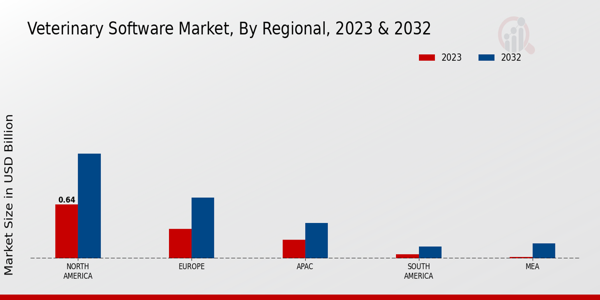Veterinary Software Size
Veterinary Software Market Growth Projections and Opportunities
The veterinary software market is expected to grow to USD 0.49 Billion by 2030 with a CAGR of 8.9%. The next eight years are the forecast period from 2022 to 2030. The Veterinary Software Market landscape is shaped by multiple factors that determine the dynamics of the market as well as its development outlook. Among the main issues is the necessity for the development of the effective and smooth veterinary practice management systems. The field of veterinary software covers different types of software like electronic health records (EHR), appointment scheduling, billing, inventory management, etc. Different aspect such as more efficient workflow, better animal health, and compliance with the regulation are the reasons of the widespread adoption of veterinary software by the clinics and animal care facilities.
The veterinary software market is being propelled by technological advancements with the primary role played in taking it ahead. Progressive improvements in software construction, cloud services, and mobiles devices are presented in the rise of complex veterinary software systems. These features that include telemedicine capability, digital imaging, as well as mobile access to patients records evolves the efficiency and conveniences of veterinary practice management.
Regulation and standards implementation play a massive role in the development of the Veterinary Software Industry. Veterinary practice must follow the rules that concern the medical record privacy, the recordkeeping, and the billing practices. It is important to note that the compliance with these standards is necessary for software vendors. Therefore, veterinary professionals should choose and use only software/ solutions that meet regulatory requirements so as to avoid legal and ethical implications in practice management.
The evolution of preventive care, personalized medicine, and client engagement curbs the need for Vet Software. Through integrated software solutions veterinary practices can track the history of each pet, keep a schedule for preventive care visits and communicate with pet owners via online portals. To make veterinary care better, a vet should develop individual treatment plans and ensure a better communication with the pet owners (clients).
Economic factors such as cost-effectiveness and ROI are important also in regard to the adoption of Veterinary Software. Vets examine the financial architecture of integrating software technology taking into account initial costs, training expenses, and ongoing maintenance among others. The vendors have to demonstrate cost savings results such as reduced errors, enhanced client satisfaction, improved efficiency with the hope that this will make the software market competitive.
Interoperability and international partnership are two key to progress in the Veterinary Software Market. Working together with veterinary practitioners, technology vendors and regulatory body, will ease introduction of standardized data exchange platforms and approaches to interoperability. Harmonious interface of animal care software suppliers across various veterinary offices and practice is requisite to ensure the care continuum and optimal service delivery.



















Leave a Comment